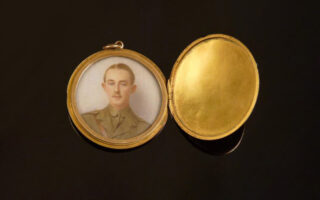
Despite appearances and what seems like neglect for his body, Vickery Pinfield was not forgotten. Soon after his death in 1916 The Illustrated London News published his photo on their Roll of Honour. His obituary in The Times announced the much loved only son of Mrs P. Russell had been killed in action in Ireland. At Marlborough College his name appears with 742 others who lost their lives during the Great War 1914–1918. His fellow officers erected a plaque to his memory that is located within St. Patrick’s Cathedral in Dublin, the only plaque in the cathedral connected to the Easter Rising. In his home town of Bishops Stortford, his name appears in the local church and town war memorial. His old rugby club at Rosslyn Park also have his name on their memorial. To his family, friends and community Vickery Pinfield was not forgotten, but for the wider world he would have remained another unknown statistic of the Irish Easter Rising if it were not for the recent auction of the locket. This prompted a number of researchers to investigate the story of this young man and why his body was left in the grounds of Dublin castle for so many years.
The 15 carat gold memorial locket sold for £850 and carries his image. It is engraved with the words of the Hussars’ motto “Pristinae Virtutis memores” (The memory of former valour). The officers initials ‘GVP’ and his place and date of death, Dublin April 24th 1916, are also to be found on the locket which his mother wore throughout her life. A letter to her from a brother officer in Pinfield’s regiment may disclose one of the reasons why his body was not removed from the castle and repatriated to England. The officer states that Pinfield’s remains were to be buried within the Castle environs in consecrated ground, a fitting resting place as it was just a few feet from where he fell. It is possible that Pinfield’s mother took solace in this and left the remains of her son where she believed they would be tended to by the military.

To most of the world the 1916 Easter Rising was over-shadowed by events on the Western Front later that year. The Battle of the Somme followed that summer and the 116 British soldiers killed during the insurrection in Dublin city were listed as ‘killed at home’. The British military and government were reluctant to remember soldiers killed in Dublin during the rebellion, as the event had caused some embarrassment.
In Britain, Remembrance Day recalls those British and allied servicemen and women who died in two World Wars. The first of these ceremonies took place on the 11th November 1919. As the years went by, the event was commemorated by a two-minute silence, church services and parades to newly erected memorials. In Ireland these events became controversial with the establishment of the Irish Free State in 1922 and in the years that followed, the memories of the war and those who had fallen became a private recollection for those who had served or who had lost loved ones during the conflict.
Many of the men and women who fought in Dublin city that Spring over 100 years ago have been consigned to dusty annals, a page in an archive or a paragraph in a book. With the passing of time, we are growing ever more distant from one of the most important events in Irish and British history and those from both sides who took part.
The locket that was sold at auction to an unknown Irish bidder had been specifically made to commemorate Guy Vickery Pinfield. Every headstone in a cemetery has a story to tell and Lieutenant Pinfields’ was no exception.
This article first appeared in The Irish Times, May 2013.
About the Author
Paul O’ Brien MA, a military historian and author, works for the Office of Public Works and is currently based at the Royal Hospital, Kilmainham. The author of fifteen books, he has written extensively on the 1916 Rising, the British Army in Ireland and a number of local histories. He lives in Santry, Dublin with his wife, daughter and two cats. Stay up to date with the author at: paulobrienauthor.ie


